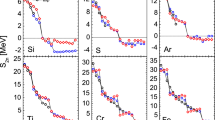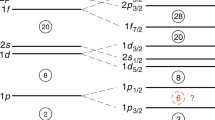Abstract
Physics of three-body forces in connection to exotic nuclei will be discussed. Three-nucleon forces (3NF), especially Fujita–Miyazawa 3NF, are shown to be the key for the solution to the long-standing problem of oxygen drip line, which deviates from basic trend towards the stability line. Three-body forces produce repulsive modifications to effective interaction between valence neutrons, and make the ground states less bound. The oxygen drip line is then located at the right place. The relation to the neutron matter is presented. Applications to Ca isotopes will be presented. The shell evolution due to the 3NF depicts the raising of single-particle energies and the widening of splitting among the orbits. This is in contrast to the so-called shell quenching. The 2+ levels are calculated for Ca isotopes, suggesting about the same sub-magic structure for N = 32 and 34.
Similar content being viewed by others
References
Tanihata I. et al.: Measurements of Interaction Cross Sections and Nuclear Radii in the Light p-Shell Region. Phys. Rev. Lett. 55, 2676 (1985)
Hansen P.G., Jonson B.: The Neutron Halo of Extremely Neutron-Rich Nuclei. Europhys. Lett. 4, 409 (1987)
Otsuka, T.: Exotic nuclei and nuclear forces. Physics with radioactive beams. In: Proceedings of Nobel Symposium 152. Goteborg, Sweden, 10–15 June 2012 (Phys. Scr., T152, 2013, 014007)
Otsuka T., Suzuki T., Fujimoto R., Grawe H., Akaishi Y.: Evolution of Nuclear Shells due to the Tensor Force. Phys. Rev. Lett. 95, 232502 (2005)
Otsuka T. et al.: Magic Numbers in Exotic Nuclei and Spin-Isospin Properties of the NN Interaction. Phys. Rev. Lett. 87, 082502 (2001)
Otsuka T. et al.: Novel Features of Nuclear Forces and Shell Evolution in Exotic Nuclei. Phys. Rev. Lett. 104, 012501 (2010)
Tsunoda N. et al.: Renormalization persistency of the tensor force in nuclei. Phys. Rev. C 84, 044322 (2011)
Langevin M. et al.: Production of neutron-rich nuclei at the limits of particles stability by fragmentation of 44 MeVu 40Ar projectiles. Phys. Lett. B 150, 71 (1985)
Guillemaud-Mueller D. et al.: Particle stability of the isotopes 26O and 32Ne in the reaction 44 MeV/nucleon 48Ca+Ta. Phys. Rev. C 41, 937 (1990)
Fauerbach M. et al.: New search for 26O. Phys. Rev. C 53, 647 (1996)
Sakurai H. et al.: Evidence for particle stability of 31F and particle instability of 25N and 28O. Phys. Lett. B 448, 180 (1999)
Otsuka T., Suzuki T., Holt J., Schwenk A., Akaishi Y.: Three-Body Forces and the Limit of Oxygen Isotopes. Phys. Rev. Lett. 105, 032501 (2010)
Fujita J., Miyazawa H.: Pion Theory of Three-Body Forces. Prog. Theor. Phys. 17, 360 (1957)
Hjorth-Jensen M., Kuo T.T.S., Osnes E.: Realistic effective interactions for nuclear systems. Phys. Rep. 261, 125 (1995)
Green A.M.: Nucleon resonance in nuclei. Rep. Prog. Phys. 39, 1109 (1976)
Entem D.R., Machleidt R.: Accurate charge-dependent nucleon-nucleon potential at fourth order of chiral perturbation theory. Phys. Rev. C 68, 041001(R) (2003)
Epelbaum E., Hammer H.-W., Meissner U.-G.: Modern theory of nuclear forces. Rev. Mod. Phys. 81, 1773 (2009)
van Kolck U.: Few-nucleon forces from chiral Lagrangians. Phys. Rev. C 49, 2932 (1994)
Epelbaum E. et al.: Three-nucleon forces from chiral effective field theory. Phys. Rev. C 66, 064001 (2002)
Utsuno Y., Otsuka T., Mizusaki T., Honma M.: Varying shell gap and deformation in N~20 unstable nuclei studied by the Monte Carlo shell model. Phys. Rev. C 60, 054315 (1999)
Utsuno Y., Otsuka T., Mizusaki T., Honma M.: Onset of intruder ground state in exotic Na isotopes and evolution of the N = 20 shell gap. Phys. Rev. C 70, 044307 (2004)
Honma M., Otsuka T., Brown B.A., Mizusaki T.: Effective interaction for pf-shell nuclei. Phys. Rev. C 65, 061301(R) (2002)
Honma M., Otsuka T., Brown B.A., Mizusaki T.: New effective interaction for pf-shell nuclei and its implications for the stability of the N = Z = 28 closed core. Phys. Rev. C 69, 034335 (2004)
Honma, M., Otsuka, T., Brown, B.A., Mizusaki, T.: Shell-model description of neutron-rich pf-shell nuclei with a new effective interaction GXPF1. Eur. Phys. J. A 25(s01), 499 (2005)
Honma M. et al.: Shell-model description of neutron-rich Ca isotopes . RIKEN Accel. Prog. Rep. 41, 32 (2008)
Zuker A.P.: Three-Body Monopole Corrections to Realistic Interactions. Phys. Rev. Lett. 90, 042502 (2003)
Hagen G. et al.: Continuum Effects and Three-Nucleon Forces in Neutron-Rich Oxygen Isotopes. Phys. Rev. Lett. 108, 242501 (2012)
Brown G.E., Green A.M.: Three-body forces in nuclear matter. Nucl. Phys. A 137, 1 (1969)
Fritsch S., Kaiser N., Weise W.: Chiral approach to nuclear matter: role of two-pion exchange with virtual delta-isobar excitation. Nucl. Phys. A 750, 259 (2005)
Tolos, L., Friman, B., Schwenk, A.: Neutron matter at finite temperature. Nucl. Phys. A 806, 105 (2008)
Hebeler, K., Schwenk, A.: Chiral three-nucleon forces and neutron matter. arXiv:0911.0483 [nucl-th] (2010)
Holt J., Otsuka T., Schwenk A., Suzuki T.: Three-body forces and shell structure in calcium isotopes. J. Phys. G Nucl. Part. Phys. 39, 085111 (2012)
Hagen G. et al.: Evolution of Shell Structure in Neutron-Rich Calcium Isotopes. Phys. Rev. Lett. 109, 032502 (2012)
Suzuki, T., Otsuka, T., Honma, M.: Spin-dependent modes in nuclei and nuclear forces. In: Proceedings of International Symposium on Nuclear Structure and Dynamics. Opatija (2012) [AIP Conference Proceeding 1491, 21 (2012)]
Caurier E. et al.: The shell model as a unified view of nuclear structure. Rev. Mod. Phys. 77, 427 (2005)
Author information
Authors and Affiliations
Corresponding author
Rights and permissions
About this article
Cite this article
Otsuka, T., Suzuki, T. Three-Body Forces and Neutron-Rich Exotic Nuclei. Few-Body Syst 54, 891–896 (2013). https://doi.org/10.1007/s00601-013-0667-4
Received:
Accepted:
Published:
Issue Date:
DOI: https://doi.org/10.1007/s00601-013-0667-4




